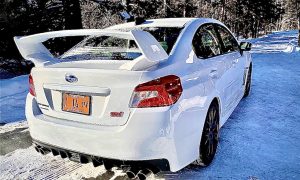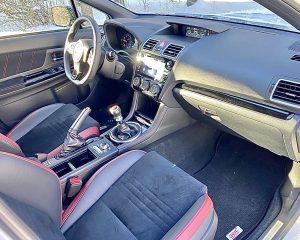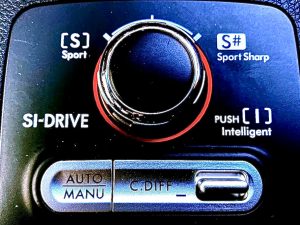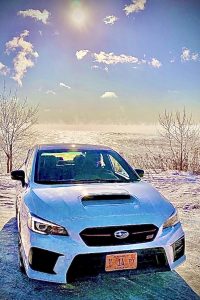WRX STI still sets pace for Subarus

The air was colder than Lake Superior’s water, creating steam as the Subaru WRX STI paused on the North Shore. — Photo by Jack Gilbert.
By John Gilbert
The sun was shining brightly out of the pure blue sky, helping define the phenomenon of wispy clouds of “sea smoke” rising off the North Shore of Lake Superior. My older son, Jack, who often assists my car-testing and photography couldn’t pass it up, getting me to park just right so he could shoot some photos of my test-drive car of the week, a 2021 Subaru WRX STI.
Parking it facing away from the water made the pure-white vehicle appear almost mystical, as if it was a motorized monster rising out of the sea. The attraction, for Jack and for me, was that the WRX STI is a no-compromise screamer, a true hot-rod that dates back decades and still sticks stubbornly to that identity. The photos speak for themselves.
One of the most exciting parts of being able to test-drive the newest models of cars from all over the world is to get an advanced, week-long taste of the delicacy of new designs and new technology — an element that has taken on more significance as we move toward hybrids and all-electric vehicles.
At the same time, sometimes you’ve eaten so many delicacies that it’s time to “clean your palate” between courses by forgetting all the latest high-tech stuff and gorging yourself on “comfort food.” That’s what the 2021 Subaru WRX STI represents. Meatloaf and mashed potatoes, with some sort of vegetable and a salad.
When Subaru went from making somewhat odd flat-opposed engine subcompacts and sedans four decades ago, or so, I watched and drove Subaru models as they strived to make deeper inroads in the standard U.S. car scene, and then it branched off into making a true hot-rod. At the time, Mitsubishi, one of Subaru’s Japanese rivals, was competing in all-terrain endurance racing, and that was where Subaru made its bid.
There were various Subaru models that had grown up before Subaru made its first Impreza subcompact sedan. When going to high performance became a trend, Subaru rebuilt an Impreza with a much more powerful engine, a special manual transmission, greatly strengthened springs and shock absorbers, and they also decided to give it some flash, by adding various air vents and identifiably unique contours. For good measure, Subaru plunked a gigantic airfoil on the rear deck while also carving a gigantic horizontal vent in the hood. Inside, firmer seats and driver-centered instruments made it a unique four-seat, four-door sedan.
The concept wasn’t totally unique to Subaru, because Mitsubishi had similarly built its Lancer subcompact up into a four-door screamer called the Evolution. Both of them had all-wheel drive, and both extracted amazing power out of their little 4-cylinder engines. The two battled ferociously in endurance racing, and it wasn’t long before they also took it to the road-racing tracks of summertime. There were two distinct camps dividing those who liked the WRX STI and those who loved the Lancer Evolution.
The Evolution has long since passed on, but Subaru keeps building the Impreza, and the WRX STI, which has branched off to become its own brand in recent years. It has remained unchanged, in style and purpose, for most of the past decade, and word is, Subaru is planning to make an all-new designed WRX STI for 2022, which caused some to figure there would not be a 2021 model.
For example, Motor Trend came out with its new-car issue and grouped together all the cars, trucks and SUVs of assorted sizes and shapes. It ran little capsules on 224 vehicles, by my count, including all manner of Subarus — the Legacy, Crosstrek, Forester, Outback, Ascent, the Impreza and the BRZ. But there was no mention of the WRX STI, even as a special spinoff model of the Impreza.
But as these photos attest, the WRX STI is alive and well, even if it now stands out as if it is a retro hot-rod in a parking lot full of highly sophisticated and trendy high-tech vehicles.
Under that hood with its large scoop there is a flat-opposed 2.5-liter engine, turbocharged to send 310 horsepower and 290 foot-pounds of torque to all four wheels. Climb inside and settle into that very supportive and tight-fitting Recaro bucket seat and the straightforward instrumentation and controls are overshadowed by the stalk sticking up from the console — a stick-shift lever for the 6-speed transmission.
Push-button start is nice, and the engine roars to life and lets you engage that hair-trigger clutch just right, after some practice that might involve killing the engine a few times as you let it out and suddenly realize that if you give it enough gas to make sure you don’t kill it, the vehicle wants to blast out from under you.
It is swift and firm, and a lot of folks who don’t recall those retro hot-rods like Challengers and Mustangs might refer to the feeling as harsh. While the standard Impreza also has evolved to have a WRX model without the STI portion, and which is much more comfortable to drive and ride in, but for the uncompromising, the WRX STI is the one to have.
It takes off like a scalded cat, corners and handles with flat disposition, and makes you feel as though you could probably whip just about any other car on the road. And it almost can.
You also can do some light off-road-type venturing, because it has a few extra instruments to tell you how far you’re leaning and how much gravity you’re defying. There is also a mode switch to give you the ability to adjust the center differential on the all-wheel-drive arrangement, while you are driving, which is handy.
While the engineering tweaks have kept up, adding the electronics and safety devices we need these days, the price has also worked its way upwards. Motor Trend says the standard Impreza lists for between $19,500 and $20,000, the WRX STI has a base price for the Limited version of $38,170, and the as-tested price on my test car was $42,870. That means it is more than double the price of the basic Impreza, which makes sense, since the transmission, powertrain, handling and brash and outright thrust of the WRX STI is far beyond doubling its sedate stablemates.
We took the WRX STI on a trip from Duluth to St. Paul and back, and I figured no matter how much power it had, we should get decent fuel economy because it is small and aerodynamic, and it has that huge rear wing. I was wrong. On the way down, I tried to match the traffic flow at about 74 miles per hour, and we registered 18.7 miles per gallon. That, frankly, is not good enough. It has been my experience that Subarus rarely if ever match the EPA estimates, but they never do if you cruise at anything over 70.
So on the way back, I refilled it — with premium, thank you — and kept it as close to 70 as possible while also feeling like I was not being a roadblock. The difference was that on the return trip I got 18.9 mpg instead of 18.7. That, also, is not good enough.
It also was very cold the week we spent together, but I couldn’t waste any fuel by using the remote start, because there was no auto-start with the stick shift. It’s a great comfort to start the vehicle with your key fob from the kitchen and let it run long enough to be warm when you climb aboard, although without it, I hopped in and took off.
There was a CD player, though, a feature I much appreciate. Very few cars have them any more, even though every car-buyer nowadays still has a few hundred CDs now virtually unplayable because manufacturers don’t provide players. I know people have moved on in huge numbers to MP3 recordings and online services, but most of us still have our CDs.
Having a little Guy Clark, or Waylon Jennings, or Neil Diamond concert stuff serenading us was a nice break from the satellite radio’s always available stuff.
It was a fun week, and great photo-op weather, and while driving the WRX STI felt like throwback time, it was impressive to hammer that thing with its winter tires mounted on all four corners, and try to imagine what Subaru has in mind for 2022. And whether Motor Trend will notice.






 John Gilbert is a lifetime Minnesotan and career journalist, specializing in cars and sports during and since spending 30 years at the Minneapolis Tribune, now the Star Tribune. More recently, he has continued translating the high-tech world of autos and sharing his passionate insights as a freelance writer/photographer/broadcaster. A member of the prestigious North American Car and Truck of the Year jury since 1993. John can be heard Monday-Friday from 9-11am on 610 KDAL(www.kdal610.com) on the "John Gilbert Show," and writes a column in the Duluth Reader.
John Gilbert is a lifetime Minnesotan and career journalist, specializing in cars and sports during and since spending 30 years at the Minneapolis Tribune, now the Star Tribune. More recently, he has continued translating the high-tech world of autos and sharing his passionate insights as a freelance writer/photographer/broadcaster. A member of the prestigious North American Car and Truck of the Year jury since 1993. John can be heard Monday-Friday from 9-11am on 610 KDAL(www.kdal610.com) on the "John Gilbert Show," and writes a column in the Duluth Reader.